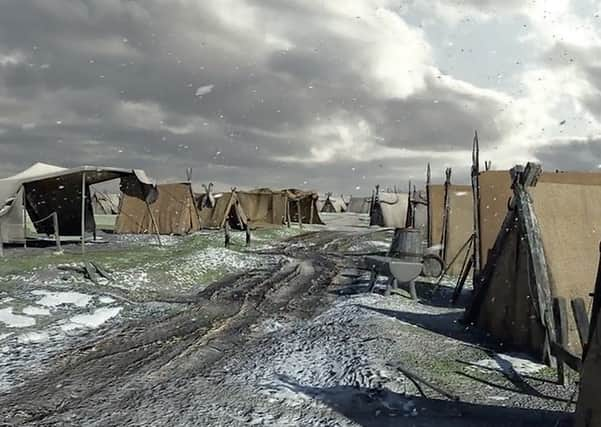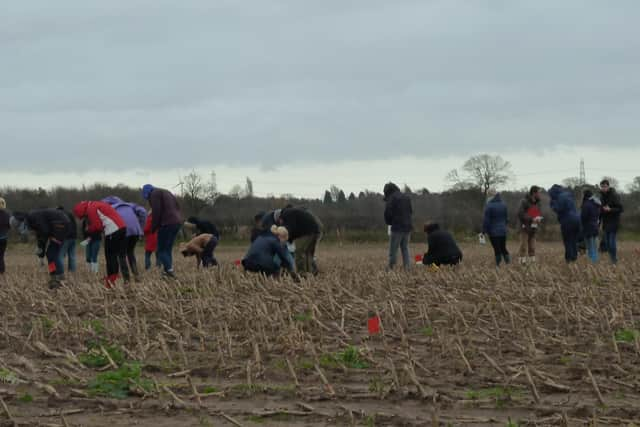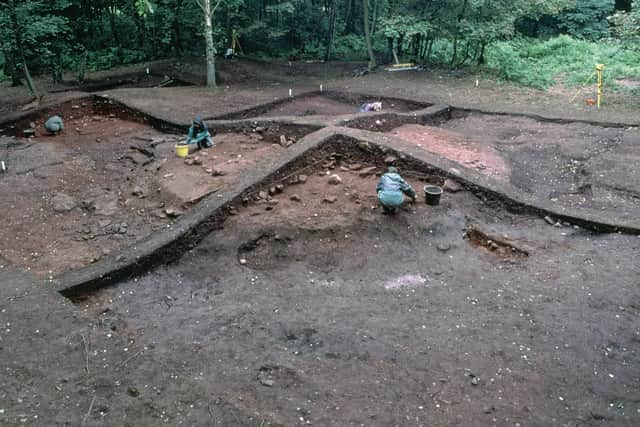Viking Great Army’s transformation of England - and Yorkshire - revealed in new book after thawing of tensions between archeologists and metal detectorists


The Viking Great Army’s invasion beginning in 865 AD and lasting for around 15 years led to numerous battles, multiple kings being killed or deposed and paved the way for England to be transformed from four kingdoms into one.
But while the dramatic events – many of which occurred in what is now Yorkshire – that are central to new book The Viking Great Army and the Making of England happened well over 1,000 years ago, authors Julian Richards and Dawn Hadley say the story they are telling is only possible because of developments in the past decade or so involving a thawing of previously-frosty relationships between archeologists and metal detectorists.
Advertisement
Hide AdAdvertisement
Hide AdThe married academic couple, who are both professors of archaeology at the University of York, have jointly created the first definitive account of the crucial historic period by building on their years of experience in the field, assessing recent discoveries and cross-referencing them with existing historical records and past finds.


Speaking to The Yorkshire Post over Zoom, Richards explains: “The primary change has been archeologists recognising the value of evidence from metal detectorists. We didn’t really know where many of the sites used by the Great Army were. It is primarily new detecting evidence that has allowed us to identify them. We are now starting to see the exact places where they camped. Twenty to 30 years ago a lot of archeologists regarded metal detectorists as just treasure hunters but there has been a real change and people are much happier to work with detectorists.”
Hadley says the advent of the Government’s Portable Antiquities Scheme to encourage the recording of small finds of archaeological interest which began as a pilot project in 1997 and has subsequently grown in size to a point where over 1.4m items have been recorded. It appears to have helped curtail the activity of ‘nighthawking’ in which unscrupulous metal detectors fail to report their finds in the hope of selling on their discoveries.
While the Vikings had carried out raids on England in the 8th Century in places like Whitby in which they would typically target monasteries for financial gain, the arrival of their massed ranks in East Anglia, also referred to as The Great Heathen Army – had a more long-term purpose. At the time, England was split into four separate kingdoms – East Anglia, Northumbria (which included modern-day Yorkshire), Mercia and Wessex. The aim of the Viking forces was to conquer the four kingdoms and they went on to depose or kill at least four Anglo-Saxon kings, installing their own appointments from the local elite as puppet rulers.
Advertisement
Hide AdAdvertisement
Hide AdThe book recounts how when the Great Army arrived in York on All Saints’ Day in 866, terrible destruction soon followed and according to one 12th century chronicler, the streets were filled “with blood and lamentation”.


A year later, two rival Anglo-Saxon claimants to the Northumbrian throne put aside their differences and attempted to retake York from the Vikings; only for them both to be killed in what was recorded by the Anglo-Saxon Chronicle as “an immense slaughter” of the Northumbrian forces.
But while their time in England involved plenty of violence, the new book reveals details of their domestic arrangements as the raiders gradually became settlers as the years went by. Much of the book focuses on the finds uncovered at the Great Army’s winter camp in Torksey, Lincolnshire, which covered a 55-hectare site and is believed to have been used around 872AD as a base for thousands of soldiers, women and children.
Hadley explains: “When you look at what we know of towns of this period, this looks like a bigger area than an contemporary town. It is much bigger than York was.”
Advertisement
Hide AdAdvertisement
Hide AdThe site was first discovered in 1989 by Dave and Pete Stanley, two metal-detecting brothers from South Yorkshire, who went on to make a vast number of finds there in the following years.


Among the items discovered were Islamic dirhams, believed to have been brought over by the Viking invaders from their previous travels. The brothers spoke to an expert at the Fitzwilliam Museum in Cambridge who then called in Richards and Hadley to encourage them to conduct an archeological investigation of the site.
Thousands of pieces of metalwork and coins have now been recovered from the area, while gold finds suggest the camp was used as a place to melt down church treasures taken by the Vikings. Remnants of costume jewellery was also found, as well as more than 300 conical pieces of lead which the book suggests are likely to have been board game pieces. “We can envisage long winter evenings spent sitting around the camp fire, reliving past battles, plotting tactics for forthcoming encounters and gambling looted treasure on the outcome of board games,” it states.
Richards adds what was left behind were the equivalent of what might be discarded after a modern-day music festival. “There is nothing deliberate about the items like you would get from a burial. That gives us a clearer sense of who the Vikings were. It is showing us those everyday qualities.”
Advertisement
Hide AdAdvertisement
Hide AdUsing the features found at the site, like the lead gaming pieces, and cross-checking it with finds from other parts of the country included on the PAS database allowed Hadley to identify for the first time numerous other sites in eastern Lincolnshire and Yorkshire that were visited by the Great Army.
Hadley says: “When you work on the Vikings, you have got this limited body of written evidence that you are always going back to on one level. But archeology is the one area where the knowledge is growing. It means you can go back to things discovered in the 19th century and reassess them with your new knowledge. It is a subject that is dynamic in a way you might not expect. Once you start putting it together, it is almost really obvious and you think, of course they must have come here. You have a new way of understanding what was going on in the late 9th century.”
One site which exemplifies the Vikings’ gradual shift from raiders to settlers is Cottam in East Yorkshire.
Metal detectorist Dave Haldenby first brought Richards to the site in 1992 and archeological study of the area has gone on to reveal it to be the first Viking farmstead found in eastern England as well as a site once visited by the Great Army.
Advertisement
Hide AdAdvertisement
Hide AdMetal detectorists were also responsible for discovering what the book describes as “one of the most important Viking sites to be discovered this century”, Aldwark, which sits 12 miles north-west of York.
The site was the subject of an infamous Time Team special in 2008 notable for tensions between archeologists and the metal detectorists.
The new book says it is a “reasonable hypothesis that Aldwark is actually the site of the Great Army’s winter camp at York”, in part because the redevelopment of Viking York as a trading and manufacturing town did not take place until at least a generation after the arrival of the Great Army, suggesting they were largely based elsewhere.
The Great Army secured territory in three of the four Anglo-Saxon kingdoms but were unable to defeat King Alfred in Wessex. The Great Army was eventually replaced by fresh Viking forces but by 927 AD, Alfred’s grandson Athelstan became the first Anglo-Saxon ruler of the whole of England as he conquered York, which was by then the last remaining Viking kingdom.
Advertisement
Hide AdAdvertisement
Hide AdThere were many further steps to build an English nation but this was a fundamental period in building the identity of the country we live in today.
Their continuing impact is seen in the extraordinarily high proportion of Scandinavian-influenced place names ending in either -by or -thorp. In East Riding, 48 per cent of place names suggest this connection, with 46 per cent in North Riding and 31 per cent in West Riding.
Hadley explains for good or ill, the Great Army changed England in a way that still has ramifications centuries on.
“The activity of the Viking Great Army led to the collapse of the four English kingdoms and ultimately paved the way for the beginning of England. In the three kingdoms that disappeared they wouldn’t have seen that as good. One thing the Vikings did is reinforce some of those strong regional identities that still carry on to this day.”
TV programmes ‘show continuing fascination of the Vikings’
Advertisement
Hide AdAdvertisement
Hide AdThe enduring fascination with the Vikings can be seen in the interest in television programmes and books about the series, says Julian Richards.
Netflix is currently working on a fifth series of The Last Kingdom, which is based on Bernard Cornwell’s The Saxon Stories novels.
The first series of the show focused on the arrival of the Great Army in England.
The drama series Vikings has been shown on Amazon Prime in recent years, with a follow-up Vikings: Valhalla in development. Richards says: “It seems that every generation creates their own version of the Vikings to match whatever set of circumstances they are in. I guess we all do that.”
The Viking Great Army and the Making of England is out now.
Advertisement
Hide AdAdvertisement
Hide AdSupport The Yorkshire Post and become a subscriber today. Your subscription will help us to continue to bring quality news to the people of Yorkshire. In return, you’ll see fewer ads on site, get free access to our app and receive exclusive members-only offers. Click here to subscribe.
Comment Guidelines
National World encourages reader discussion on our stories. User feedback, insights and back-and-forth exchanges add a rich layer of context to reporting. Please review our Community Guidelines before commenting.